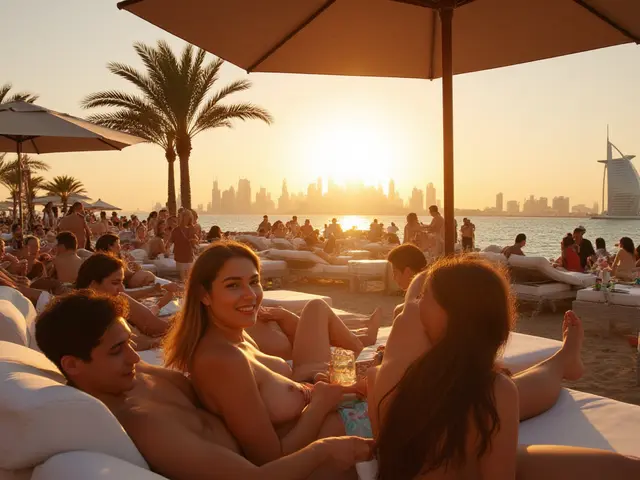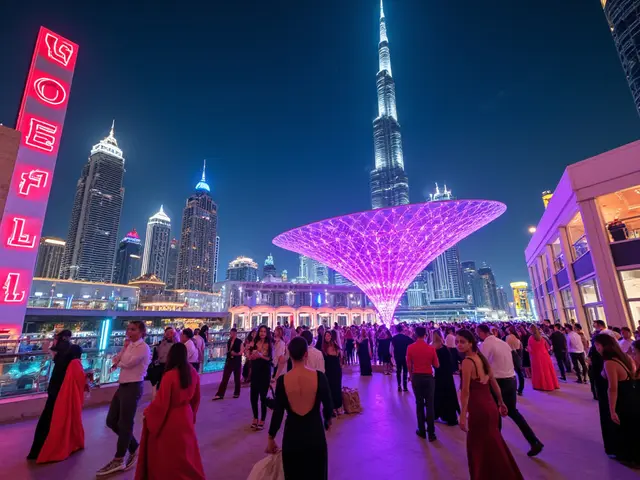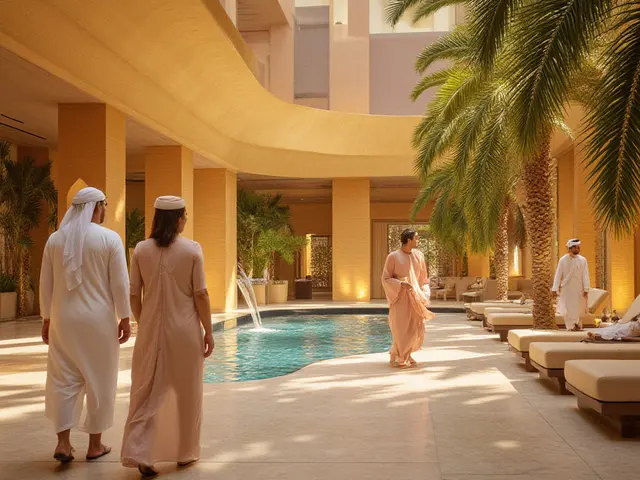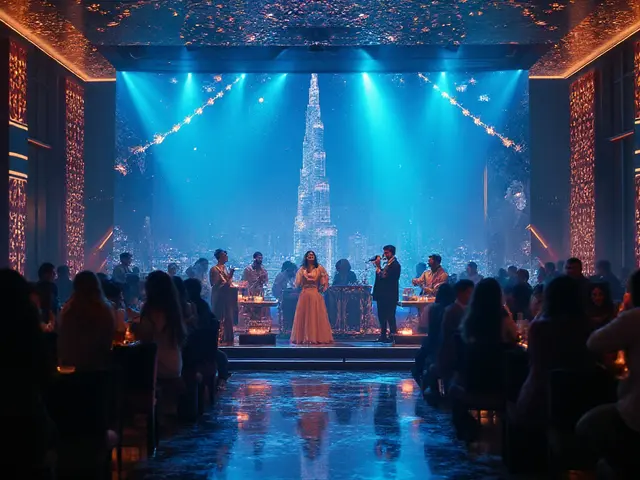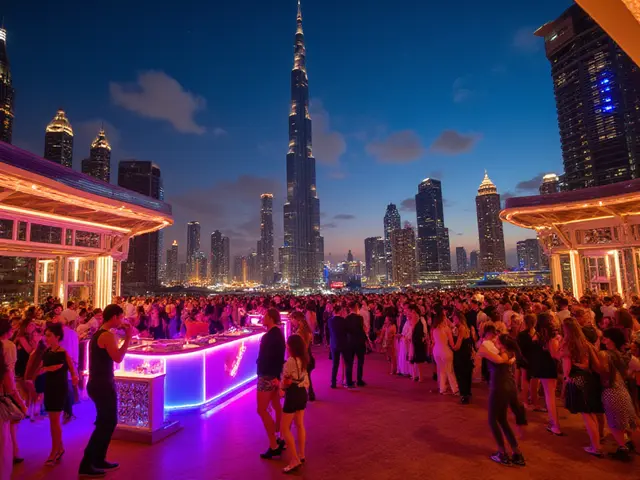Imagine the golden hour in Dubai, as sunlight dances across spires and domes. Among all the skyscrapers and futuristic masterpieces, nothing draws both locals and travelers quite like the Jumeirah Mosque. This iconic landmark isn’t just another photo stop—it feels alive, pulsing with stories that reflect a fusion between tradition and modernity. If you’ve ever been stuck in Friday evening traffic on Jumeirah Beach Road and spotted its creamy-white silhouette, you’ve had a small taste of the allure that keeps people coming back.
A Living Landmark: Jumeirah Mosque’s Story and Cultural Pulse
Jumeirah Mosque isn’t hidden away in a quiet corner; it stands proud right in the heart of one of Dubai’s busiest districts. Built entirely from white stone, the mosque glows under Dubai's relentless sun. Its two minarets and central dome borrow from the Fatimid tradition of Egypt, which is a rare sight in the Gulf. Break free from the idea that mosques are all off-limits—Jumeirah Mosque is one of the very few in the city that openly welcomes non-Muslims for guided tours. This makes it a powerful symbol of Dubai’s push for openness, blending deep respect for Emirati heritage with an authentic invitation for discovery.
Construction began in 1976, but its design looks straight out of a medieval Arabian storybook. You don’t just recognize it from the outside—step in, and you’ll spot cool marble floors, intricate geometric tiles, calligraphy, and an abundance of peaceful corners. The mosque can accommodate up to 1,200 worshippers at a time, making Friday prayers a special moment here. But what makes this place even more important to Dubai residents is its role as an ambassador of faith and culture. Since 1998, the Sheikh Mohammed Centre for Cultural Understanding has been hosting daily tours that feel more like honest conversations than formal lectures. People ask questions about Emirati life, what Ramadan is like, and even the meaning behind Islamic clothing—all without judgement.
Visitors from all backgrounds share a traditional Emirati snack (dates and Arabic coffee, served with a big smile), right where Dubai locals and expats brush shoulders. Locals often drop by for a quiet prayer or just a walk in the tranquil gardens that surround the mosque. On UAE National Day, you’ll find the façade bathed in decorative lights and the area buzzing with activity. Expats living around Jumeirah appreciate the mosque as a living neighborhood landmark, a nightly reminder that Dubai is more than luxury shopping and towering glass. There’s something grounding about hearing the call to prayer, knowing centuries-old customs are still alive even as Teslas whizz past outside.
If you’re considering a visit, don’t rush. The guided tour runs at 10am every day except Friday. Arrive early—parking fills up quickly, especially during tourist season—and bring a hat or scarf. Dress modestly, but don’t stress: the team provides traditional abayas and kanduras as needed. If you bring children, you’ll notice how welcome they are, especially during open Q&A sessions (kids often ask the most insightful questions). For families living in Dubai, this mosque has become a regular pitstop to introduce their kids to the cultural heartbeat of the city. Ramadan nights here feel magical: after sundown, the hustle quiets down, and you’ll hear laughter carry across the gardens during community iftars.
The Craft of Beauty: Architecture, Details, and What to Look For
Most mosques in the city blend into the dazzling skyline, but Jumeirah Mosque stands apart, taking you on a trip back in time. Its striking white façade is built from carved stone imported from Syria, carved and chiselled by artisans whose families have passed down the craft for generations. The architecture is a direct homage to the Fatimid style, marked by bold lines, elegant arches, and symmetrical minarets that reach for the sky. If you get up close to the main gate, pause and notice the texture—every panel is uniquely patterned, yet comes together in harmony.
The high central dome, flanked by two slender minarets, is a classic feature in Islamic architecture but the fine details make this mosque feel personal. Inside, you’re greeted with a flood of natural light pouring through stained-glass windows—the patterns shift throughout the day, creating a kaleidoscope on the prayer rugs. Step back and admire the stunning Arabic calligraphy that runs along the upper walls, including verses of the Qur’an interpreted by local artists commissioned specifically for this mosque. Ceiling chandeliers glitter through intricately carved wooden medallions; these were handmade in workshops in Sharjah, a detail often missed unless you look up.
The mosque’s prayer hall isn’t just large; it’s designed for clarity and comfort. Acoustics have been finely tuned so every word of the imam can carry clearly to the back rows, something worshippers appreciate during the packed Friday prayers. The mihrab (the prayer niche pointing toward Mecca) is wrapped in turquoise and gold tiles, while the minbar (the pulpit) displays craftsmanship that rivals the city’s best woodwork. Underfoot, imported Persian carpets soften every step—they’re replaced every decade, usually after Ramadan, and the selection process is a big deal, with new designs unveiled at Eid.
If you’re into details, bring a camera or your sketchbook; photos are allowed and encouraged, though certain areas are best enjoyed quietly. Local art students sometimes set up just outside to draw the mosque at different times of day. Even longtime Dubai residents still gasp when the mosque lights up at twilight—a ritual signaling maghrib (evening prayer) that casts long shadows down the street. You might stumble upon cultural events or workshops organized by the Centre, covering everything from Arabic calligraphy to henna art. These gatherings attract not just novices, but practicing artists, expats, and even architecture students from Dubai’s universities.
Practical tip: The courtyard garden is perfect for unwinding after a long day. Shaded benches, gentle fountains, and palm trees make it easy to linger, even during the city’s hotter months. Don’t forget to explore the side colonnades, where you’ll often find a docent ready to share trivia—for instance, did you know the mosque uses high-efficiency cooling systems custom-built for the Gulf climate? Those small vents along the base aren’t just for looks; they channel wind in a nod to ancient Emirati architecture. On rare rainy days, the mosque’s drainage system diverts water to water the palms, making it one of the city’s more eco-conscious religious buildings.
| Jumeirah Mosque Facts | Details |
|---|---|
| Year Opened | 1979 |
| Capacity | 1,200 worshippers |
| Architectural Style | Fatimid (Egyptian influence) |
| Visitor Tours | Daily, 10am except Fridays |
| Special Events | Ramadan iftar, UAE National Day illuminations |
Just next door is a community library of Islamic texts in Arabic and English—a great stop if you’re teaching, researching, or just browsing for inspiration. Nearby cafes (like those in City Walk or the original Lime Tree) are popular with people finishing a morning mosque visit, often winding up in heated debates or gentle conversations about the meaning of tolerance in Dubai life. If you have friends or family visiting the emirate, bringing them to the Jumeirah Mosque isn’t just a tourist move; it’s a subtle way to share what makes daily life in this city layered and special.
How to Experience Jumeirah Mosque Like a Local
Tour buses swing by every day, but there’s another way to enjoy this Dubai treasure—slow down and see it through the eyes of those who call the city home. The best time to visit, honestly, isn’t when there’s a crowd of selfie sticks (though you’ll get fantastic photos either way). Early mornings during winter—when the temperature drops and air is crisp—feel intimate and reflective. The serenity is only broken by birds chattering overhead and occasional joggers making their way down Jumeirah Beach Road.
For residents, Jumeirah Mosque is a bridge between the old Dubai (before City Walk, before The Dubai Mall) and the city’s ever-changing present. Locals recall a time when the surrounding area was mostly sandy lots dotted with low villas. Today, you’re a stone’s throw from swanky hotels like the Mandarin Oriental, and the new beachfront promenade is full of art installations and food trucks. Still, the mosque retains its authenticity. Emirati families often choose it for their children’s Islamic studies, and newly arrived expats join tours to quickly learn cultural etiquette—like how to greet with a right hand, or the significance of removing shoes.
Unlike many historic landmarks that feel like museums, the Jumeirah Mosque is both revered and lived-in. You’ll see business professionals duck in for midday prayers between meetings, and taxi drivers catching a few cool moments in the garden shade. On Fridays, it’s not unusual to bump into Dubai influencers snapping photos outside (but always respectfully—there’s an unspoken code about when and where pictures feel right).
Here’s a tip: if you’re joining a scheduled tour, come with genuine curiosity instead of just ticking a box. The guides, many of whom grew up in Dubai or moved here years ago, will answer any question, no matter how basic or complex. Questions range from “How does the call to prayer work?” to “Where do Dubai locals spend Eid?” and even “Can I try on local attire?”—the answer is yes, and the photo opps are worth it.
Trying the snacks served during the tour—fresh dates and steaming gahwa—connects you to traditions still vibrantly alive in Emirati households. Sign up in advance for workshops if you want something extra; spots fill up quickly during Ramadan or around public holidays. If you’ve got visiting parents, taking the shaded walk to La Mer beach after the mosque tour is an easy win: it lets you pair cultural immersion with a laid-back afternoon by the sea.
Don’t worry if you’re not up to speed on Islamic terms or architecture; what matters at Jumeirah Mosque is authenticity, humility and a spirit of learning. The venue actively encourages respectful dialogue. This isn’t about reliving history in a glass case, but picking up what it feels like to be part of Dubai’s ongoing social experiment. Flip through the guestbook in the entrance lobby for stories from people who’ve traveled halfway around the globe just to experience the mosque’s warmth.
For all the talk of glass towers and luxury, it’s spaces like Jumeirah Mosque that make Dubai feel genuinely connected. If you’re seeking a balance between old and new, sacred and social, glitz and groundedness, this spot has your answer. Don’t just breeze by—join an open conversation, savor a cup of Arabic coffee, snap that perfect shot, and watch Dubai’s promise of tolerance come alive for real. For the city’s residents, there’s a quiet pride in having such an open, welcoming oasis just around the corner; a reminder that true luxury isn’t always about scale or spectacle, but in a warm greeting and an open door.

